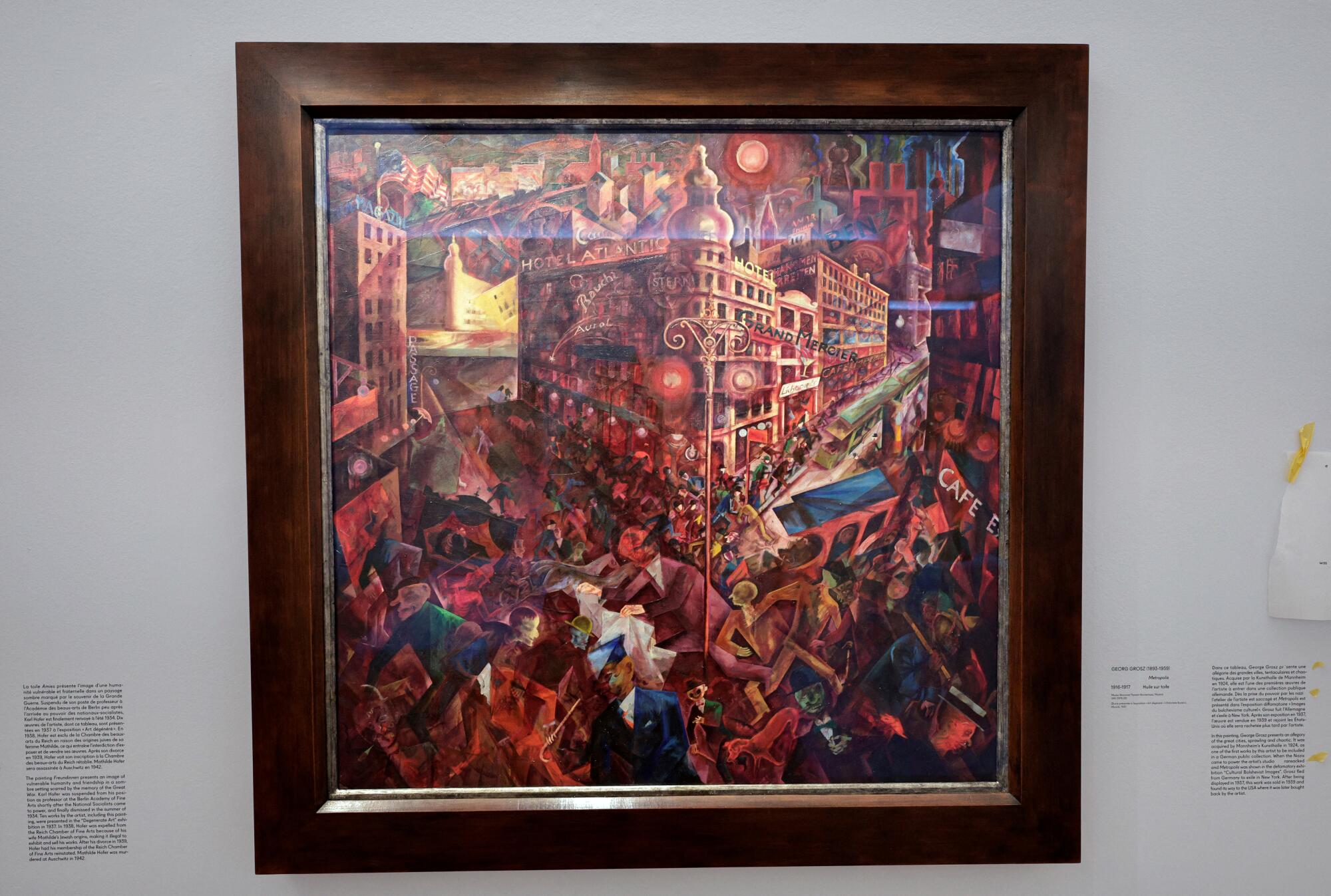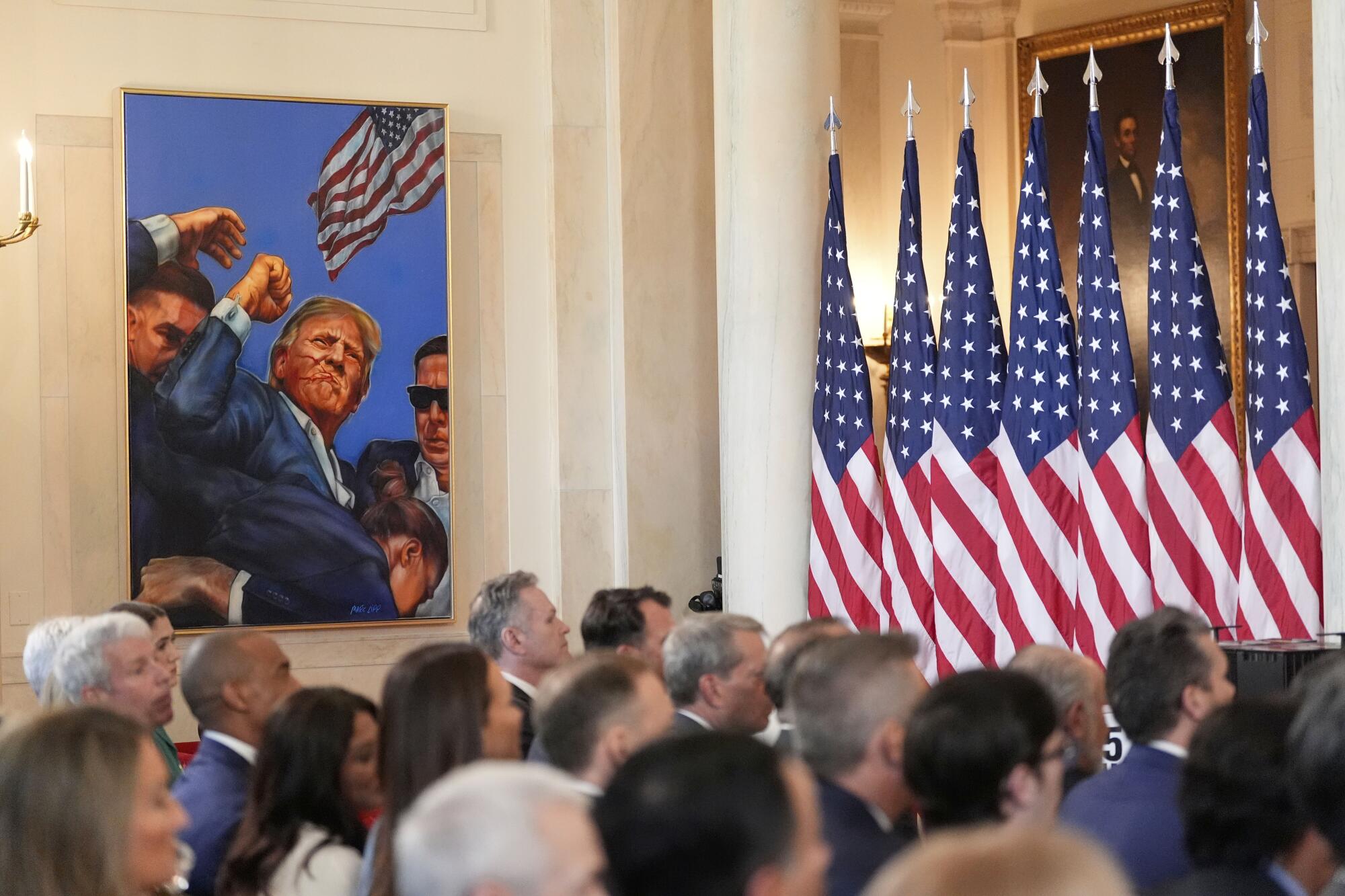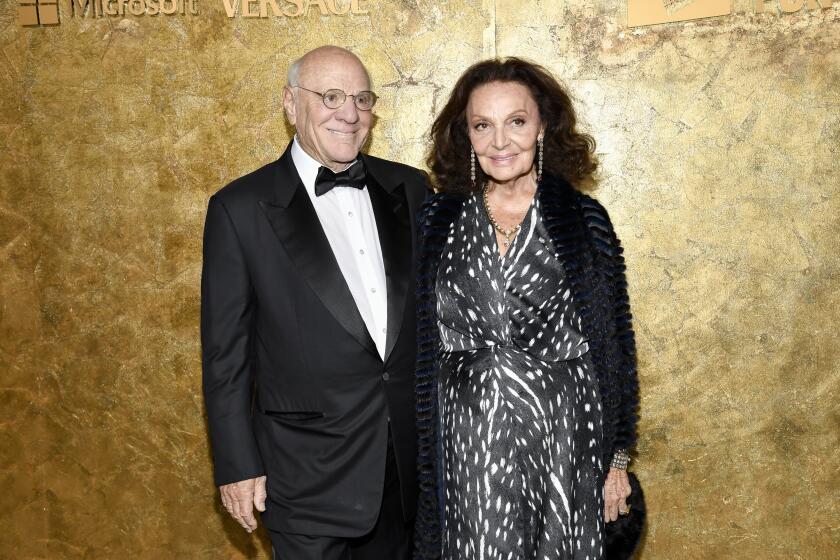
- Share via
PARIS – If all you saw of the exhibition at the Picasso Museum here was the art itself, you would recognize at once that here are wonderful canvases, powerful canvases, from many decades and countries and artists — Van Gogh, Klee, Picasso of course, Kandinsky, Chagall, landscapes, portraits, abstracts and striking sculpture.
But what’s the theme, the organizing concept?
It’s hate.
The unifying theme is that every one of these works, and thousands more, were despised and maligned by Hitler and the Third Reich as “degenerate art,” destined to be burned up, sold off, hidden away, or lost during the 10-plus years of the Nazi crusade against any art that it decreed was too modern, too un-German, work that Nazis said was created by “idiots,” “criminals,” “speculators,” “Bolsheviks” and “Jews.”
The exhibition, “Degenerate Art: Modern Art on Trial Under the Nazis,” is at this museum until May 25. It’s in Paris’ Marais district, once the center of the city’s Jewish life. And it’s the first such exhibition in France.
It takes a lot of time to assemble so many artworks from so many different collections and museums, but the show launched serendipitously not quite a month after Donald Trump was sworn in as president.
His name does not appear in the exhibit, but a connection is palpable if not visible.
Since Trump took office, the art world has watched his mission to end “woke” art in taxpayer-funded federal programs and institutions. He justified his takeover of the John F. Kennedy Center for the Performing Arts by claiming on social media that he would put an end to “woke” performances of drag shows and “anti-American propaganda.” He filled its board with allies who voted him in as director. He’s cut the entire National Endowment for the Arts funding from his proposed budget. Vice president JD Vance has been tasked with removing “improper ideology” from the Smithsonian Institution, those things and ideas that “degrade shared American values” or “divide Americans based on race.”

This French museum’s show offers a flashback to the era when, apart from the works including those displayed here, the artists who created them were reviled and persecuted. Ernst Ludwig Kirchner, whose glamorous 1913 “Rue a Berlin” is here, died by suicide in 1938.
Otto Freundlich’s striking Easter Island-style human head was on the cover of the original July 1937 Nazi exhibition guide to some 700 “degenerate” works, and beneath it the German word for “art” — “KUNST” — in capital letters and quote marks, leaving no question that the Nazis did not regard it as art at all.
Freundlich was sent to a concentration camp on March 4, 1943, and died there five days later. Before the fatal train departed, he wrote a note to his partner and fellow artist, Jeanne Kosnick-Kloss, ending, “May heaven protect you and give you strength. I love you and will always be with you.”
Room by room, the works unfurl their themes, among them “Race and Purity,” “Purging German Museums” and “Trade in Degenerate Art.”
In 1933, Marc Chagall’s intense painting of a rabbi, “The Pinch of Snuff,” was an obvious target. Taken out of a museum in Mannheim, pulled through the city streets on a handcart, inviting Germans to mock it, and then set in an art gallery window with the sign, “Taxpayer, you should know how your money was spent.”
Others make you wonder how they came to be reviled. Why would a striking Van Gogh landscape, “Field of Poppies,” be offensive? Probably because the Nazis classed him as anti-traditional as well as insane, as they did the avant-garde artist Elfriede Lohse-Wächtler. She was committed to an asylum, where she drew portraits of her fellow patients, some on display here. The Nazis murdered her under their forced euthanasia program.

George Grosz’s canvas “Metropolis” was painted during World War I and shows a nighttime street teeming with the delights and vices of city life. The Nazis put it on display and then sold it at auction, in 1939, as they did many of the artworks they damned, to finance their handiwork. The painting wound up in New York. So did Grosz, who years later bought it back himself.
Most of the work is vertical, on the walls. But horizontally, under glass in a large table, this caught my attention: an engrossing collection of 1930s and 1940s newspaper clippings Picasso kept — he was quite the packrat — about the Hitler “degenerate” purges.
My French is pretty fair, so I think I read it right. One article, on Aug. 20, 1937, is from the French illustrated weekly Voila, which was edited by a pair of Jewish brothers. The article appeared a month after July 18, 1937, when Hitler opened a Munich museum of approved Nazi artworks. The next day, he visited the “degenerate” art exhibition.
Voila used the back-to-back events to mock Hitler and his taste in art, as well as “the violence of his methods and the scale of his offensive” against modern art.
It begins by reminding readers of the incompetent doctors in the plays of French playwright Moliere, men who endangered their patients’ lives. It then likens Hitler to a doctor who cautions German artists to “paint according to my directives, otherwise you’ll be sterilized.”
Instead, the writer imagines Hitler advising Germans to paint “scenes from the life of the SS and the SA,” Hitler’s armed Nazi forces, along with depictions of heroic young athletes in the mode of the mythic German hero Siegfried, and “opulently formed women.”
Stingingly, the article shows readers some examples of Hitler’s own work, the rather stodgy and static products of a draftsman who aspires to art. Hitler twice applied and was twice rejected for admission to Vienna’s Academy of Fine Arts, which remarked on his “unfitness for painting.”
The article notes that the mighty fuhrer had very recently “wielded a paintbrush,” and “not only as a housepainter.”
That last is a sly point that’s been an enduring comic take of Hitler’s artistic preening. There’s debate of long standing that Hitler’s crusade against “degenerate” art grew in part from his academy rejections.
The “housepainting Hitler” trope got a big boost, and a big laugh, in Mel Brooks’ 1967 film “The Producers.” The title characters find the worst screenplay they can, written by a crazed ex-Nazi soldier played by Kenneth Mars. The schnappsed-up Mars goes on a rant against Winston Churchill, “with his cigars, with his brandy, and his rotten painting! Rotten! Hitler — there was a painter! He could paint an entire apartment in one afternoon — two coats!”

With Trump now issuing an executive order about the contents of federal art institutions, his own artistic tastes are being highlighted, like his fondness for paintings of himself, and his touchiness about them. He and his supporters have shared “fan” portraits of him painted as a boxer, a general and a king. He recently received — reportedly from Vladimir Putin — a portrait of himself with raised fist after the assassination attempt in Pennsylvania last year.
A portrait of him that had hung in the Colorado state capitol for almost six years — a painting commissioned by Colorado Republicans and paid for by a $10,000 GoFundMe campaign — recently was taken down after it came to Trump’s attention and he proclaimed it “truly the worst” image of himself.
In 2016, the Washington Post detailed how Trump had spent $20,000 of his charitable foundation’s money to buy a large portrait of himself, which was said to have been installed in his New York golf club.
Years before, when Trump invited his biographer Tim O’Brien aboard his plane as O’Brien was researching his 2005 book “Trump Nation,” O’Brien spotted what looked like the Renoir painting “Two Sisters (on the Terrace).” O’Brien said Trump told him, “You know, that’s an original Renoir.”
In a Vanity Fair podcast, O’Brien said he told Trump, “Donald, it’s not.” He said, “I grew up in Chicago, that Renoir is called Two Sisters on the Terrace, and it’s hanging on a wall at the Art Institute of Chicago.”
The original has, indeed, hung in the institute for more than 80 years. The Trump copy appeared to have been moved to Trump Tower, O’Brien said, because it could be seen in the background when “60 Minutes” interviewed Trump there not long after the 2016 election.
The day before Germany’s 1937 “degenerate” art exhibit debuted, Hitler opened another art show, also in Munich — an apotheosis of Germanic taste, the “great German art exhibition.” Much of his speech was spent attacking the art he didn’t like.
“Cubism, Dadaism, Futurism, Impressionism, etc., have nothing to do with our German people … I will therefore confess now, in this very hour, that I have come to the final inalterable decision to clean house, just as I have done in the domain of political confusion, and from now on rid the German art life of its phrase-mongering.”
“ … with the opening of this exhibition, the end of German art foolishness and the end of the destruction of its culture will have begun. From now on we will wage an unrelenting war of purification against the last elements of putrefaction in our culture … “
The German artist Otto Dix was unsparing in his painted critiques of war. He’d already been under the disapproving eyes of Nazis for years, and several months before the Munich “degenerate” art exhibit, he flung down this challenge in a letter to his fellow “degenerate” artists: “Then let’s stay what we are. Long live degeneracy!”
Explaining L.A. With Patt Morrison
Los Angeles is a complex place. In this weekly feature, Patt Morrison is explaining how it works, its history and its culture.
More to Read
The biggest entertainment stories
Get our big stories about Hollywood, film, television, music, arts, culture and more right in your inbox as soon as they publish.
You may occasionally receive promotional content from the Los Angeles Times.












